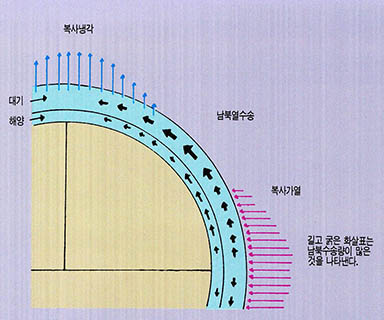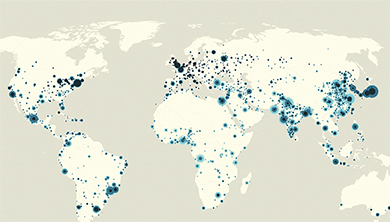칼럼이(한명의 필자가 아닌) 공동으로 노력으로 쓰여질 때 일인칭 복수를 이해하기 힘든 문제가 있다. '우리'란 필자들인 아이작 아시모프와 자넷 아시모프 일 수 있고, 혹은 필자중 나이가 더 많은 사람인 아이작 아시모프가 지난 1920년 우주선을 타고 지구로 옮겨 왔다는 유언비어가 있었음에도 불구하고 필자들이 속한 '우리 사람들'일 수 있다. 우리가 '우리 사람들'이나 '인간'이라고 말하면 그말 뜻 그대로 읽으면 될 것이다. 혹시 우리가 잊고 쓰더라도 이해해주기 바란다.
만약 아이작 아시모프가 지난 1920년에 우주선을 타고 지구에 왔다면 그는 우주의 실상을 지구인보다는 훨씬 많이 봤을 것이다. 그는 안드로메다성운이 가까이 있는지(우리 은하계의 일부일만큼) 혹은 멀리 있는지에 관해 천문학자들인 커티스와 할로우 샤플리 사이에 벌어졌던 그 해의 논쟁을 우스꽝스럽다고 여겼을 것이다. 대부분의 천문학자들은 안드로메다가 가깝게 자리잡고 있다고 생각했는데, 1923년 에드윈 허블은 새로 개발된 1백인치형 윌슨산 망원경으로 그 성운을 관찰했다. 그는 개개의 별들을 관찰한 후 '케페우스 변광성'이라 불리는 별들을 이용해 그 거리를 계산한 다음 안드로메다 성운이 분명히 다른 은하계라는 사실을 밝혀냈다.
천구를, 지구를 중심으로 도는 별들과 맴도는 행성들 그리고 태양과 달의 무대인 둥근 천장으로 그려왔던 사람들의 생각을 초기의 망원경들이 부정했던 반면 월슨 산의 망원경은 인간의 우주에 관한 사고를 돌이킬 수 없도록 바꾸어 놓았다. 곧이어 안드로메다 외의 다른 '성운'들이 은하계 저 멀리서 관찰되었던 것이다. 우리의 은하수만 존재하는 것이 아니라 갑자기 우주는 그 누가 생각했던 것보다 훨씬 거대해졌다.
기술의 진보는 인간이 저밖에 멀리있는 실상을 더욱 잘 볼 수 있도록 해주지만 신기술이 매일 등장하면서도 오래된 철학적 의문들은 여전히 남는다. 현실이란 보기에 따라 달리 해석될 수 있기 때문이다.
광학망원경들은 우리 은하계에 있는 먼지들 뒷면은 보지 못하는데 전파망원경으로는 가능하다. 지난 1983년 새로 제작된 적외선 탐사용 인공위성은 약50만개의 적외선 분출지를 찾아냈다. 약 1년전엔 로샛위성의 X선 망원경이 하늘의 90%를 넘는 영역에서 수천개의 X선 출처를 찾아냈다. 이 자료는 그 X선 출처들이 현재까지 알려지지 않은 물체인지 아니면 이미 다른 망원경으로 찾아낸 것인지 판별하기 위해 검토되고 있다. X선을 방출하는 물체들에 관한 로샛위성의 최근 탐색작업은 행성간에 있는 찬가스속이나 은하계들의 주위와 사이에 있는 뜨거운 가스속에서 무슨 일이 벌어지고 있는지는 물론, 별들의 탄생과 진화와 작동과 소멸까지 설명해 줄 수 있는지 모른다.
멀리있는 실상을 정확하게 표현한다 함은 무엇이 보이느냐 뿐 아니라 무슨 시각으로 보느냐에 따라 달라진다. 은하계는 지구에서 어느 각도로 보나 기울어져 있으므로 천문학자들은 시각과 은하계의 명도나 크기 등을 연결시켜 보는데 문제점을 가질 수 있다. 과거에도 이와 같은 연구는 거리를 고려하지 않음으로써 밝기나 크기에 관해 잘못된 결론을 내리곤 했다.
한편 먼지에 둘러싸인 우리 은하계의 중심에 과연 어떤 실체가 존재하는지를 밝히는 노력은 흥미진진한 모험이 된다. 최근 천문학자들은 그 중심을 차지하고 있는 것은 블랙홀이라는 데 보다 강한 확신을 갖게 됐다. 이제 문제는 정확히 어디냐는 것이다. 전파 발산지 한곳과 적외선 출원지 한곳이 주요한 후보 위치들이다. 맞는 곳이 발견되면 진짜 중심이 어디인지가 밝혀질 것이다.
우주에 관해 알려진 실상들은 희미한 물체들을 분별하는 우리의 능력이 증가함에 따라 하루하루가 다르게 점점 재미있게 나타나고 있다. 태양보다 1만배 더 희미한 별들도 발견됐는데 그중 하나는 제법 가까이 위치하고 있다(태양계에서 가장 가까운 행성인 센타우루스자리의 알파성까지 거리의 8배의 거리밖에 되지 않는다). 최근 발견된 희미한 은하계들은 헬륨보다 무거운 요소들을 포함하고 있는데 이는 그 은하계들의 가스가 아직도 대폭발 이후의 상태에 머물고 있으리라고 짐작하게 한다. 어두운 은하계들에 관한 연구는 초기의 우주가 어떠했는지를 이해하는데 도움을 줄 수 있을는지 모른다.
허블망원경은 많은 결점이 있음에도 불구하고 우주의 기막히도록 멋진 실상을 우리의 가정으로 전해준다. 이 실상을 확장해보면 엄청나게 폭력적이라는 연상도 가능하다. 별들은 불에 타고 무너져 부서지고 파괴되며 폭발한다. 어떤 은하계들은 서로 충돌하고 있고 또한 과거엔 분명 충돌했던 것처럼 보인다. 은하계의 중심들엔 빛까지도 삼켜버리는 블랙홀이 수많은 별들과 활활타며 흐르는 가스에 둘러싸여 있다.
멀리있는 우주의 실상은 그저 무서운 것이라기보다는 지구에 사는 인간들에게 외로움과 위태로움을 느끼게 만든다. 인간의 눈엔 한계가 있다. 희미한 모습은 망막의 색깔을 감지하는 원추형 세포들을 흥분시키지 못해 좋은 망원경을 사용해도 은하계는 색깔이 없는 것처럼 보인다. 그러나 멀리서 벌어지는 모든 회색빛 폭력은 우리의 잘못된 인식일 뿐이다.
천연색 필름을 이용하면 우주는 갑자기 그 아름다움을 자태뿐 아니라 색깔로 나타낸다. 물론 천문학자들은 필름으로부터 얻은 그 천연색 영상이 과연 '현실'인지 잘 몰라 저 멀리로 직접 방문해 자신들의 눈으로 직접 확인할 수 있었으면 좋겠다고 생각한다. 그들은 왜 그 많은 성운들이 모두 꼭같이 어두운 붉은 색인지 궁금해한다. 그러나 중요한 것은 우주는 아름답다는 사실일 것이다.
색깔과 모양과 의미를 담은 아름다움이란 눈으로 바라보는 사람에게 뿐 아니라 눈이 사용되는 방법과 무슨 장비의 협조를 얻었느냐에 따라서도 달리 나타난다. 그러나 어쩌면 가장 멋진 아름다움은 멀리있는 우주를 그리는 우리 마음속에 존재할는지 모른다.
Far-out Reality
When a column is a collaborative effort, there's a problem about the first-person plural. 'We" could mean Janet and Isaac, or it could mean "we humans," in which category both of us fall despite rumors that the senior writer was decanted from a spaceship in 1920. We'll say "we humans" or "humanity" when we mean that. If we forget, bear with us.
If the senior writer had come from a spaceship in 1920, he'd have seen the reality of the universe better than any Earthman. He'd have been amused by that year's debate between astronomers H.D. Curtis and Harlow Shapely over whether the Andromeda "nebula" was close (part of our Milky Way galaxy) or far away. Most astronomers thought it was close, but in 1923 Edwin P. Hubble used the new 100-inch Mount Wilson telescope on Andromeda. He saw individual stars, calculated the distance using stars called "cepheid variables," and found that Andromeda was indeed a separate galaxy.
Early telescopes negated humanity's picture of a simple vault of heaven in which the field of stars, the wandering planets, the sun and moon all moved around the Earth, but the Mount Wilson telescope irrevocably changed humanity's idea of the universe. Soon, other "nebulosities" besides Andromeda were shown to be far-off galaxies. Our Milky Way galaxy was not alone, and suddenly the universe was much bigger than anyone thought.
Technology goes on improving humanity's view of the reality out there, but as new technological achievements appear every day, the old philosophical questions linger, for reality depends on how you look at it.
Optical telescopes don's see past the dust in our own galaxy;radio telescopes do. In 1983, the new Infrared Astronomical Satellite located 500,000 infrared sources. Less than a year ago, the Rosat satellite's X-ray telescope found many thousands of X-ray sources over 90 percent of the sky. The data is being examined to find out whether the X-ray sources are objects previously unknown or already found by other telescopes. Rosat's current investigation of X-ray-emitting objects may explain much about the birth, evolution, functioning and death of stars, as well as what goes on in the cold gas of interstellar space and in the hot gas around and between galaxies.
Accurately describing far-out reality depends not just on what you're looking at, but the angle of view. Since galaxies are tilted every which way to Earth's line of sight, astronomers have a problem correlating the viewing angle with what seems to be a galaxy's brightness and size. In the past, these studies have apparently come to erroneous conclusions about brightness and size because distance was not taken into account.
Then there's the adventure of trying to find the reality that exists at the center of our Milky Way galaxy, shrouded in dust. Lately, astronomers are more certain that a black hole occupies the center. The question is, exactly where? One radio source and one infrared source are the chief candidates. The correct one, when found, may indicate the real center.
The known reality of the universe gets more interesting every day as our ability to distinguish dim objects grows.. Stars 10,000 times dimmer than our Sun have been found, one fairly close (only eight times further out than Alpha Centauri).
Very dim galaxies found recently contain few elements heavier than helium, which means that their gas is probably still in the state it was in after the Big Bang, Studying dim galaxies may help us understand what the universe was like early on.
The Hubble telescope, for all its flaws, brings home the fantastic "reality" of the universe. The expanding picture of this reality seems overwhelmingly violent. Stars burn, collapse, explode destructively. Some galaxies are colliding or obviously did in the past. Galactic centers seem to to contain black holes that swallow even light itself and are surrounded by packed stars and fiery flowing gas.
The far-out reality of the universe is more than a trifle frightening, making humanity feel lonely and vulnerable here on our one living planet. Human eyes are limited - faint images don't activate the color-perceiving cone cells of the retina - so that even with a good telescope, galaxies appear colorless. But all that far-out gray violence is our misperception.
Using color film, the universe suddenly acquires beauty not just of pattern but of color. True, astronomers aren't sure whether the color images from film are "real," and wonder what they'd see with naked eyes if they could visit far out. They wonder why so many nebulas all seem to be exactly the same side of red. But what matters is that the universe is beautiful.
Beauty - of color, pattern and meaning - is not only in the eye of the beholder, but in the way the eyes are used and augmented by equipment. Perhaps the most amazing beauty of all is the effect of this far-out universe on the human mind.
이 기사의 내용이 궁금하신가요?
기사 전문을 보시려면500(500원)이 필요합니다.
1992년 05월 과학동아 정보
🎓️ 진로 추천
- 천문학
- 물리학
- 지구과학

















